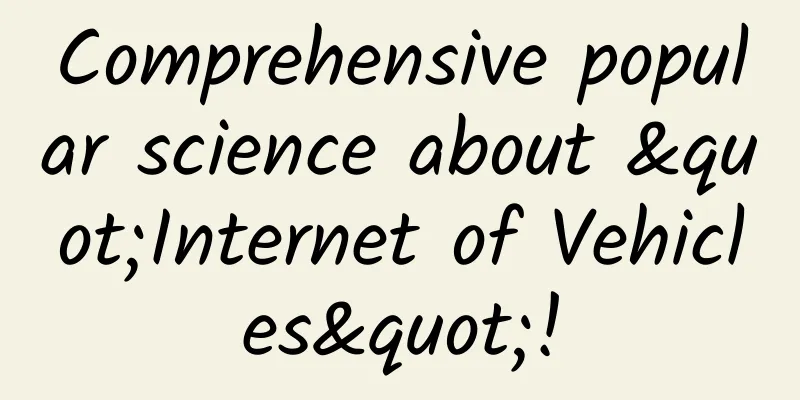Comprehensive popular science about "Internet of Vehicles"!

|
Speaking of the Internet of Vehicles, I believe everyone must be familiar with it. Nowadays, whether it is car manufacturers, dealers, or Internet companies such as Alibaba and Tencent, they often mention it. Simply put, the Internet of Vehicles is to connect cars to form a network. However, from a macro perspective, the Internet of Vehicles is actually a very large system. What many people know about the Internet of Vehicles may only be a small part of the Internet of Vehicles system. Today, I would like to give a comprehensive introduction to the Internet of Vehicles, hoping to explain the relevant concepts of the Internet of Vehicles and help everyone understand the Internet of Vehicles in a concrete, objective and rational way.
This article will focus on the following questions:
Okay, without further ado, let’s get straight to the point. What is Internet of Vehicles? The Internet of Vehicles, called IoV (Internet of Vehicles) in English, is a type of Internet of Things (IoT). Vehicle means vehicles or transportation. When we learned English before, we all knew that cars are called car, bus, and truck. In fact, foreigners use vehicle more often, which is equivalent to a general term. As mentioned before, the Internet of Vehicles is a network that connects cars together. In fact, to be precise, the Internet of Vehicles does not just connect cars to each other, it also connects cars to pedestrians, cars to roads, cars to infrastructure (traffic lights, etc.), cars to networks, and cars to the cloud. Here are several car networking concepts that we often see:
No matter what V2 is, it can be collectively referred to as V2X (X stands for everything). Some students regard the above V2 as the Internet of Vehicles, which is inaccurate. In fact, the real Internet of Vehicles is V2X (Vehicle to Everything). Pre-installed car networking and after-installed car networking Before discussing V2X, let’s first look at the vehicle itself, that is, let’s look at the interior of the car. A car consists of many parts, such as air conditioners, audio, cameras, engines, tires, etc. These parts can be informationized and digitized. By installing sensors, data that express the status can be generated. For example, tires can be equipped with tire pressure sensors to generate tire pressure data and monitor the status of the tires. With data, it can be transmitted. The data of each component in the car is transmitted to the "nerve center" of the car. This kind of network can be called "in-car network". Sensor technology is very important for in-vehicle networks. The sensors here are not just for collecting in-vehicle information, but also for collecting sensor data outside the vehicle, such as anti-collision sensor information, cameras that sense changes in the external environment, sensors that monitor road conditions, etc. These sensor data are related to the comfort and safety of the vehicle. In addition to the sensors, the more critical thing is the "nerve center". Generally speaking, car manufacturers like to assemble the Internet of Vehicles equipment, which serves as the "nerve center", when producing cars, which is usually called "pre-installed Internet of Vehicles". Representatives of pre-installed systems include Ford's SYNC, GM's OnStar, SAIC's inkaNet, Geely's iNTEC, and Changan's Incall. The pre-installed car networking system generally consists of four parts: the host, the vehicle-mounted T-BOX, the mobile phone APP and the background system. T-BOX is Telematics BOX (Telematics is a compound word of Telecommunications and Informatics), also known as TCU (Internet of Vehicles Control Unit). Simply put, it is a computer (embedded) installed in the car to control and track the car status. T-BOX Non-automotive manufacturers such as Internet companies cannot participate in the early stages of automobile manufacturing, so they can only install on-board terminals for the Internet of Vehicles through aftermarket services. The representative of aftermarket is Tencent's Lubao Box. This is a device that is installed later to obtain real-time vehicle data through the car's OBD interface. OBD stands for On-Board Diagnostic, an onboard automatic diagnostic system. Tencent Lobo OBD port on the car This device obtains data through the OBD interface and then transmits the data to the mobile phone through Bluetooth and other means.
Note that in addition to hardware, software is also important for this nerve center, so companies like Alibaba have developed an in-vehicle intelligent operating system (VOS, Vehicle Operating System) such as YUN OS Auto. It is equivalent to Android for mobile phones and is an operating system for cars. In short, whether it is front-end or rear-end, whether it is hardware or software, it is all for acquiring data, monitoring and controlling the vehicle. Keep going, keep going. If the vehicle itself does not have the ability to communicate with the outside world, then the "in-car network" is a local area network, an isolated island. The car's "nerve center" can inform the driver of the vehicle's condition through the dashboard or central control. Or, as just mentioned, it can connect to the mobile phone via Bluetooth to transmit data. However, this method is insufficient in terms of transmission speed, data volume, timeliness, convenience, etc. Therefore, we need to find a way to make the vehicle have sufficiently powerful external communication capabilities. DSRC vs LTE-V Pay attention! This part is crucial! Realizing external communication of vehicles has very high requirements, because vehicles usually move at high speeds and over long distances and large areas. In the early days, in order to realize external communication of vehicles, DSRC technology (DeDICated Short Range Communications, dedicated short-range communications) was used. This technology was proposed by the American Society for Testing Materials (ASTM) in 1992 for ETC services. After continuous improvement, it became the IEEE's Internet of Vehicles communication technology standard (802.11p). For a long time, DSRC has been the mainstream vehicle networking communication technology in countries like the United States, and many countries still use it as the mainstream standard. How DSRC works
DSRC technology is actually similar to installing Wi-Fi on the side of the road and allowing vehicles to communicate through this Wi-Fi. As the name suggests, "dedicated short-range communication" means that it is suitable for communication within a short distance. If the distance is long, there will be problems in reliability and other aspects. So, which technology has the longest communication distance? Of course it is cellular mobile communication! That is the mobile phone communication we use. Since the 21st century, cellular mobile communications have developed rapidly, with rapid progress in both technology and industry ecology. As a result, people have begun to study the use of cellular communication technology for Internet of Vehicles communications. What is our most mainstream cellular communication technology standard at present? Of course it is 4G LTE. In September 2014, LG submitted a draft specification for LTE in V2X communication applications to 3GPP. In December of the same year, Ericsson submitted a draft specification for enhanced LTE D2D proximity services. Subsequently, in 2015, 3GPP officially launched research on LTE-V technology standardization. The speed was very fast. By September 2016, 3GPP had completed the formulation of the LTE-V2X standard in the R14 version. It can be said that LTE-V is LTE tailored for the Internet of Vehicles.
LTE-V relies on existing LTE base stations, avoiding duplicate construction, and has a much larger working distance than DSRC, providing higher bandwidth, higher transmission rate, and larger coverage. LTE-V technology includes two working modes: centralized (LTE-V-Cell) and distributed (LTE-V-Direct). LTE-V-Cell requires a base station as a control center to achieve large bandwidth and large coverage communication, while LTE-V-Direct does not require a base station as support and can directly achieve reliable communication between vehicles and between vehicles and surrounding environment nodes.
Vehicle-to-vehicle communication (V2V) to promptly notify each other of road conditions and abnormalities The competition between DSRC and LTE-V is very fierce, and both hope to become the mainstream vehicle networking communication standard. At present, our country tends to adopt LTE-V. The significance of connected vehicles The Internet of Vehicles has been talked about for many years, but it has always been lukewarm. In fact, the problem lies in the vehicle's external communication capabilities. Car manufacturers are good at making cars and can build in-car networks very well, but they cannot solve the problem of external communication capabilities. Internet companies can build software very well, but if they cannot obtain data, it is useless. Therefore, before the wide-area Internet of Things communication technology matures, it is difficult for the Internet of Vehicles to have substantive significance. Now it is different. With the help of LTE-V, the bottleneck of vehicle external communication is expected to be broken. The potential of the Internet of Vehicles is likely to be fully released. First, vehicle data is connected to the Internet, and all information about the vehicle's operating status will be transmitted to the cloud. There are a huge number of application scenarios surrounding this information and data.
For example, if the car is out of gas or electricity, the cloud will inform the owner where there is a gas station (charging station). If the data of a certain component of the car is abnormal, the cloud will analyze it and then inform the owner of the possible risks. Not only can you upload data, you can also download data. Traffic navigation, traffic congestion information, parking space data, weather information, etc. can all be downloaded into the car, and audio and video entertainment is even a piece of cake.
Based on the above basic applications, with the support of even larger cloud computing and communication capabilities, remote driving and even autonomous driving have finally become possible. Autonomous driving can be said to be the ultimate form of evolution of the Internet of Vehicles. Autonomous driving Cars and various traffic infrastructure (such as traffic lights) are all connected to the network. A powerful cloud computing system can analyze the traffic flow and congestion of the entire city, plan the routes of all road vehicles, and assist with traffic scheduling, which can maximize the efficiency of the city's transportation capacity. At the same time, it will also greatly reduce the probability of traffic accidents. Both Alibaba and Tencent have proposed the concept of "city brain", which is actually working towards this direction.
To put it simply, it is the computing power of computers that replaces human brainpower. In addition, by combining big data and artificial intelligence to analyze car owners' driving habits, companies' logistics needs, and the flow patterns of urban traffic, even greater commercial value can be tapped. In short, we are not connected for the sake of connection, but for data. With the Internet of Vehicles, we have data. With data, coupled with powerful computing power, we have everything. 5G and Internet of Vehicles So, what does the upcoming 5G have to do with the Internet of Vehicles? The LTE-V we just talked about is still not powerful enough. When comparing LTE-V and DSRC just now, careful students will find that there is one indicator that LTE-V is not as good as DSRC, that is, latency. Time delay in the Internet of Vehicles means life or death. You see, the current speed on highways is 120 km/h, which is 33 meters per second. If you brake even one second late, the braking distance will be more than 40 meters. Therefore, if remote driving or autonomous driving is to be supported, the network latency must be in the single-digit millisecond level (ms). LTE cannot do this, but 5G, as an evolution of LTE, can do it. The latency of 5G can reach 1ms, which is enough to meet the requirements. LTE will evolve to 5G, and LTE-V will then evolve to NR-V2X. In addition to latency, 5G has many advantages that LTE does not have - it has higher bandwidth, supports a larger number of connections, and supports higher mobile speeds. Therefore, 5G was born for the Internet of Things. To put it simply, the relationship between 5G and the Internet of Vehicles is interdependence. Without 5G, the Internet of Vehicles is not a real Internet of Vehicles. Without the Internet of Vehicles, 5G will lose a very important application, which means it will lose its investment source, its necessity, and its value will be greatly reduced. At present, the Internet of Vehicles is the most important application scenario for 5G and is also the scenario most likely to trigger the demand for 5G. Other IoT demands cannot form the scale and volume of the Internet of Vehicles, nor will they have such a strong driving force as the Internet of Vehicles. It can even be said that the Internet of Vehicles is a barometer of the rise and fall of 5G in the next five years. |
<<: The 5G era is coming. Will the WiFi you use every day disappear?
>>: Why SDN and IBN Require Better Network Visibility
Recommend
This is the most comprehensive summary of the IGMP protocol, bar none!
1. Introduction to IGMP IGMP (Internet Group Mana...
Don't rush to upgrade to 5G, this operation can make your 4G speed 10 times faster
Remember that at the beginning of this month, 5G ...
CMIVPS Hong Kong VPS upgrade CN2 GIA line from as low as $2/month
CMIVPS sent an email yesterday about upgrading th...
New trends: eight directions of development of the Internet of Things industry
The Internet of Things (IoT) is a technological r...
EtherNetservers: $14.95/year-1GB/40G SSD/1TB@10Gbps/Los Angeles & New Jersey & Miami data centers/Alipay supported
EtherNetservers is a rare hosting company that st...
TripodCloud: US CN2 GIA line VPS hosting $38.99/half year, 1Gbps bandwidth, optional large hard disk
Many friends are looking for CN2 GIA line VPS hos...
5G RedCap is coming soon! But how difficult is it to fully commercialize it?
According to 3GPP's plan, the latest version ...
How 5G accelerates the development of the digital economy
Today, 5G construction is in full swing and gradu...
Justhost: Multiple data centers in Russia/US, 200Mbps and unlimited data, starting from $1.96/month, Chinese/English/Russian pages available
Justhost recently adjusted its website pages and ...
To be successful in 2018, operators need to rely on these three strategies
The story of 2017 has come to an end. On the surf...
How will HTTP and DNS protocols evolve in the 5G era?
HTTP and DNS have almost become two household pro...
UUUVPS 5th Anniversary 25% off, special VPS annual payment starting from 219 yuan, Hong Kong/US 9929/4837/CN2, etc.
UUUVPS (Sanyou Cloud) is currently carrying out a...
What else does 5G have besides being fast?
The chaos in the domestic communications industry...
Let's take stock of the complaints of the three major operators, and the most ruthless complaints of the three major operators
[[438942]] There are more and more complaints abo...
1.2 trillion investment! After reaching the summit of Mount Everest, how will 5G be implemented?
Recently, China's three major operators have ...









